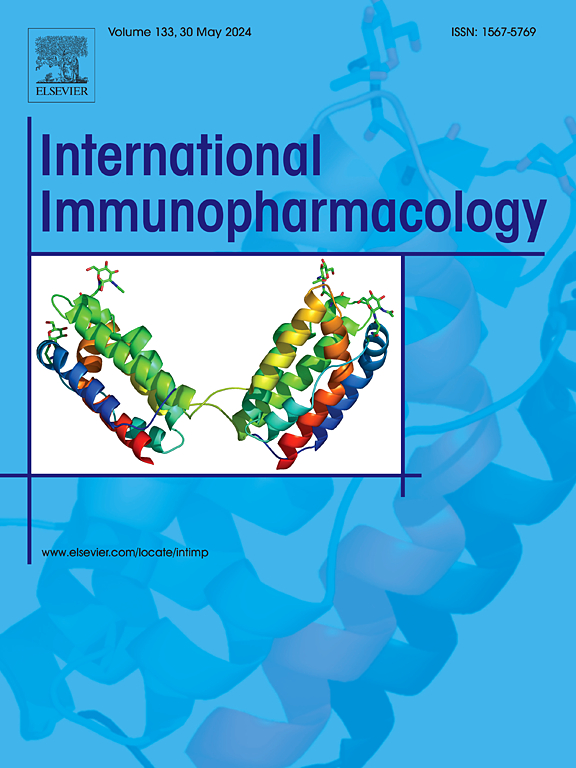促进小胶质细胞M2极化可通过5-HT6R-FYN-ERK1/2通路减轻对辛弗林诱导的CSDS小鼠抑郁样行为。
IF 4.8
2区 医学
Q2 IMMUNOLOGY
引用次数: 0
摘要
近年来,调节小胶质细胞表型转化已成为治疗中枢神经系统疾病的一种有前途的策略。枳实是一种用途广泛的中药,其主要生物活性成分为对辛弗林(p-SYN),具有抗炎作用。然而,这些作用背后的分子机制尚不清楚。本研究旨在通过慢性社会失败应激(CSDS)模型和脂多糖诱导的人小胶质细胞(HMC-3)系统,阐明p-SYN调节小胶质细胞表型和缓解神经炎症的机制。通过各种行为测试评估p-SYN的抗抑郁作用,包括社会互动、三室社会互动、蔗糖偏好、悬尾、强迫游泳、开阔场地和新奇性抑制进食测试。此外,采用LC-MS测定p-SYN的脑渗透。结果表明,p-SYN减轻了csds诱导的社交缺陷和抑郁样行为,并降低了炎症反应,其证据是TNF-α和IL-6水平降低,IL-10水平升高。p-SYN降低了M1标记物CD86和iNOS的表达,增加了M2标记物Arg-1和CD206的表达。细胞热移实验、药物亲和反应靶标稳定技术、共免疫沉淀等实验结果表明,p-SYN直接结合5-羟色胺6受体(5-HT6R),导致5-HT6R与酪氨酸激酶FYN相互作用减弱,抑制5-HT6R-FYN- erk1 /2通路。这增强了抗炎因子的产生,随后将小胶质细胞转移到M2表型,并最终减轻神经炎症,从而表现出抗抑郁的特性。本文章由计算机程序翻译,如有差异,请以英文原文为准。

Facilitating microglia M2 polarization alleviates p-Synephrine-induced depressive-like behaviours in CSDS mice via the 5-HT6R-FYN-ERK1/2 pathway
In recent years, modulation of microglial phenotype transformation has emerged as a promising strategy for treating central nervous system disorders. Aurantii Fructus Immaturus (Zhishi), a traditional Chinese medicine with versatile applications, contains p-Synephrine (p-SYN) as its principal bioactive compound, recognized for its anti-inflammatory efficacy. However, the molecular mechanisms underlying these effects remain unclear. This study aimed to elucidate the mechanisms through which p-SYN modulates the microglial phenotype and alleviates neuroinflammation using both a chronic social defeat stress (CSDS) model and a lipopolysaccharide-induced human microglial cell (HMC-3) system. The antidepressant effects of p-SYN were assessed using various behavioural tests including social interaction, three-chambered social interaction, sucrose preference, tail suspension, forced swimming, open field, and novelty-suppressed feeding tests. Additionally, brain penetration of p-SYN was determined using LC-MS. The results indicated that p-SYN mitigated CSDS-induced social deficits and depressive-like behaviours, and lowered inflammatory responses, as evidenced by decreased levels of TNF-α and IL-6 and increased IL-10 levels. Moreover, p-SYN reduced the expression of M1 markers CD86 and iNOS, while increasing that of M2 markers Arg-1 and CD206. Cellular thermal shift assay, drug affinity reaction target stabilization technology, and co-immunoprecipitation demonstrated that p-SYN directly binds to the 5-hydroxytryptamine 6 receptor (5-HT6R), leading to weakening 5-HT6R and tyrosine kinase FYN interaction and inhibiting the 5-HT6R-FYN-ERK1/2 pathway. This enhances the production of anti-inflammatory factors, subsequently shifts microglia to the M2 phenotype, and eventually mitigates neuroinflammation, thereby exhibiting antidepressant properties.
求助全文
通过发布文献求助,成功后即可免费获取论文全文。
去求助
来源期刊
CiteScore
8.40
自引率
3.60%
发文量
935
审稿时长
53 days
期刊介绍:
International Immunopharmacology is the primary vehicle for the publication of original research papers pertinent to the overlapping areas of immunology, pharmacology, cytokine biology, immunotherapy, immunopathology and immunotoxicology. Review articles that encompass these subjects are also welcome.
The subject material appropriate for submission includes:
• Clinical studies employing immunotherapy of any type including the use of: bacterial and chemical agents; thymic hormones, interferon, lymphokines, etc., in transplantation and diseases such as cancer, immunodeficiency, chronic infection and allergic, inflammatory or autoimmune disorders.
• Studies on the mechanisms of action of these agents for specific parameters of immune competence as well as the overall clinical state.
• Pre-clinical animal studies and in vitro studies on mechanisms of action with immunopotentiators, immunomodulators, immunoadjuvants and other pharmacological agents active on cells participating in immune or allergic responses.
• Pharmacological compounds, microbial products and toxicological agents that affect the lymphoid system, and their mechanisms of action.
• Agents that activate genes or modify transcription and translation within the immune response.
• Substances activated, generated, or released through immunologic or related pathways that are pharmacologically active.
• Production, function and regulation of cytokines and their receptors.
• Classical pharmacological studies on the effects of chemokines and bioactive factors released during immunological reactions.

 求助内容:
求助内容: 应助结果提醒方式:
应助结果提醒方式:


